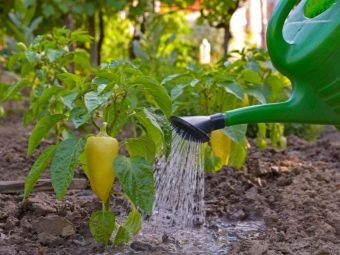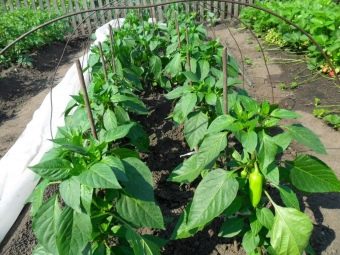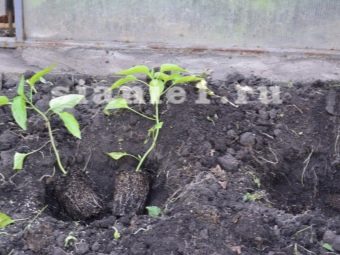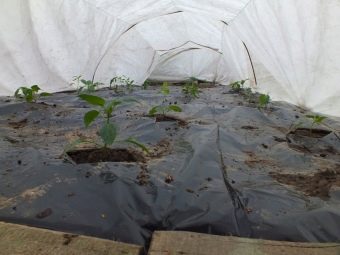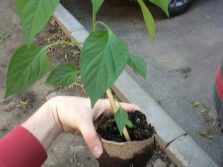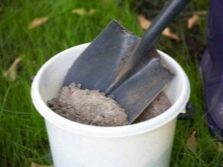What to put in the hole when planting pepper?

Even with good seeds of sweet pepper, there is no guarantee that the plant will enjoy a good and tasty harvest. Pepper is one of the most fastidious plants that requires special attention and care.In addition to the usual watering and standard care procedures, you need to feed the peppers not only during planting, but also during the entire period of its development. It is necessary to figure out what to do when planting to achieve a bountiful harvest.
How to achieve a good harvest?
First of all, you should carefully consider the planting site, trying to achieve maximum comfort for it. The main thing is that the landing site does not differ in high humidity and is well warmed by the sun's rays. In addition, planting time also plays a big role in the process of fruiting. Pepper is best planted in the ground after plants such as: cucumbers, zucchini, beans and greens.
It is not recommended to plant it on a bed where tomatoes, eggplants, tomatoes and peppers have recently grown, which will affect the yield of the plant.
Soil is important to any plant and each has its own preferences in it. For pepper, loamy and slurry soil is considered the best, that is, sand and clay are mixed and adjusted to the desired consistency. Pepper, which belongs to the family Solanaceae, does not tolerate the ground with an increased level of acid, so when planting the well, it is necessary to alkalify a little, and not to put the pepper in fresh manure. At different times, pepper needs various fertilizers. At each new stage of development, plants need different components in order to gain energy.
- The most important stage for pepper is the development of its root system. During this period, the culture not only grows rapidly, but also forms vegetative organs. To facilitate the rapid formation of this period, you must add nitrogen fertilizer. But it is worth remembering that everything is good in moderation, so if you try too hard, all the forces will focus on the development of the leaves and delay the time of ripening, and the number of fruits.
- When the time of formation and maturation, it is necessary to timely apply fertilizer with a large amount of phosphorus. For best effect, this fertilizer is poured directly into the hole at the very root of the pepper.
Pepper is one of the heat-loving plants, so immediately after it is planted in the ground it should be covered with geotextile or film. When the temperature at night rises to at least +7 degrees, only then can the protective material be removed from the plant. Such a maneuver will help the seedlings to take root and get used to the new conditions.
To achieve good yield, it is recommended to mulch the pepper with a layer of about 8 centimeters. This method will help protect the soil from dehydration and overheating on hot days. And at night, mulching retains heat well and saves pepper from the cold. All of the above actions will help grow a good pepper, which will give a lot of fruit.
What to put in the hole when planted seedlings?
For good development, pepper, like all other plants, The following components are required:
- warm water;
- good ground;
- the sun;
- certain fertilizers.
Many people neglect to feed the seedlings during planting, which is a big disadvantage in the further development of the plant. It is best to initially pay close attention to this process when planting seedlings and then do not worry about it. Plays a large role in the further development of pepper, which is put into the hole. The process of planting is very painstaking and, of course, I do not want the efforts to go in vain, so it is better to be safe and fill each hole with ash and humus. But before pouring the fertilizer into the hole, you need to shed plenty of water, but in no case should you pour cold water.
You should try to observe the thermal regime and carefully place the pepper in the hole. In such cases, it is very convenient to use peat pots for seedlings, which can be put directly into the hole.
From watering peat pots disintegrate, and will serve as an additional fertilizer for seedlings.
Landing rules
If the seedlings developed in the greenhouse, then the pepper must be carefully taken out and carefully divided the roots.Pepper is well developed in the box and the root system, expanding, intertwines with each other, in case of transplantation in no case should it be allowed to be damaged. And the stem itself is still quite fragile, so utmost care should be taken, otherwise the fragile pepper will break. When the pepper is small, it is best to replant it with a piece of land. So, the probability of damage will decrease to zero. Yes, and the seedlings will experience less stress during transplantation.
When the seedlings grow quite high, it is better to tie them to the pegs for greater support, which will save it from strong wind. Once the seedlings have been planted, it should be watered slightly, but pour water carefully under the spine, and not on the plant itself. On the second day after planting, you need to water the plant twice - in the early morning, while the sun is not too baking, and in the evening, when it has already gone down, otherwise you can burn the plant.
Do not forget that pour only warm water, because cold will slow down the growth and development of pepper. The plant is planted only after the completion of frost, when the earth is already warm enough, but in the greenhouse it can be planted in April. From the greenhouse, the plant is planted in May, just at this period the earth warms up, but it is better to be safe.
Before planting pepper in the hole, you need to pour ashes for good development, and upon completion of planting, cover it from frost. If you follow all the rules of planting and care, you can get a good harvest.
About what to add to the hole when planting pepper, see below in the video.

